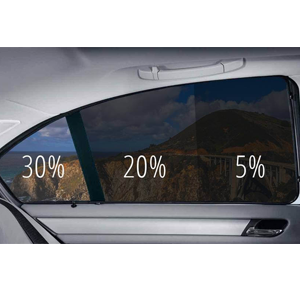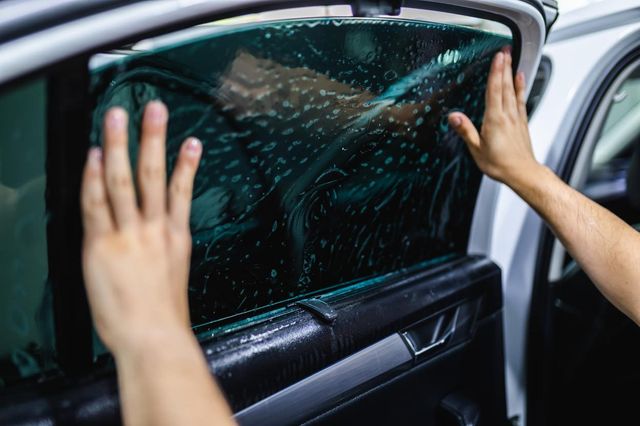A Comprehensive Overview to Recognizing Car Home Window Color and Its Advantages
Vehicle home window tinting offers greater than simply a visual purpose for cars. It provides numerous types, each with distinctive features and advantages. Recognizing these alternatives, along with lawful policies and upkeep pointers, is essential for any vehicle proprietor. The advantages might significantly enhance driving convenience and automobile durability. As one explores the nuances of window tinting, the inquiry emerges: what kind of tint is ideal fit for individual demands?
Comprehending Auto Home Window Color: What It Is and How It Functions
Vehicle home window tint serves as a safety barrier that improves lorry aesthetics while offering useful advantages. This slim movie is related to the indoor surface of car windows, decreasing glare and obstructing hazardous ultraviolet (UV) rays from the sunlight. By filtering system sunshine, vehicle window color assists to manage the indoor temperature of the automobile, causing increased comfort for guests and minimized reliance on air conditioning.Additionally, it shields the automobile's inside from fading, maintaining both furniture and control panel products. The color can likewise improve privacy, making it harder for outsiders to see inside the automobile. Certain types of home window color can increase safety; in the occasion of a mishap, the movie helps hold shattered glass together, reducing the risk of injury from flying fragments. Generally, vehicle window color offers both aesthetic and sensible objectives, making it a preferred option among car owners.
Types of Window Color: A Summary of Options
When taking into consideration window tint choices, several kinds are available, each with distinct qualities. Dyed, metalized, and ceramic home window colors provide differing levels of heat denial, UV defense, and aesthetic appeal. Comprehending these differences can help vehicle proprietors make educated selections based on their needs and preferences.
Colored Home Window Color
Colored window tint stands for a preferred selection among cars and truck proprietors seeking a efficient and affordable method to boost their car's aesthetic appeals and privacy. This sort of color is developed by positioning a layer of color between a protective finishing and an adhesive layer, resulting in a dark appearance that minimizes glow and boosts visual convenience. While colored window color effectively blocks damaging UV rays, it might not supply the very same level of heat rejection as other tint types. Additionally, its shade can fade in time, possibly reducing its performance. In spite of these drawbacks, colored window tint remains preferred for its cost-effectiveness and capacity to provide a sleek, trendy seek to numerous automobile models.
Metalized Home Window Tint
Metalized window color supplies an equilibrium of design and functionality, making it a preferred selection amongst auto proprietors. This type of tint integrates metal bits within the film, improving both visual allure and warmth rejection. The reflective top quality of metalized color helps to minimize glow and enhance personal privacy, while additionally providing UV security, which safeguards the car's inside. Additionally, metalized window color can enhance window toughness, possibly stopping ruining throughout mishaps. Nonetheless, it is vital to keep in mind that the metallic elements can disrupt electronic signals, such as GPS and cell phone function. Generally, metalized home window tint offers an efficient solution for those looking for a mix of sunlight, durability, and look defense for their cars.
Ceramic Window Color
Ceramic home window tint stands for an advanced choice in the range of vehicle home window films, supplying distinctive benefits over conventional colors. Unlike colored or metalized films, ceramic tints utilize innovative ceramic bits, which properly deny heat and UV rays without jeopardizing exposure. This technology guarantees that cars stay cooler, lowering reliance on air conditioning and boosting gas performance. Furthermore, ceramic window tints are much less likely to hinder digital gadgets, such as GPS or mobile signals, making them a useful choice for modern cars. Furthermore, their resilience and scrape resistance add to a much longer life expectancy compared to various other sorts of tints. Overall, ceramic window color provides remarkable efficiency, comfort, and defense, making it a recommended alternative for discerning lorry proprietors.
Benefits of Vehicle Window Tint: Beyond Looks
While many individuals associate vehicle home window tint with enhanced design, its advantages extend far beyond plain visual appeals. One substantial benefit is heat decrease; home window color can obstruct approximately 99% of harmful UV rays, maintaining the indoor cooler and safeguarding furniture from fading. This not only boosts comfort throughout heat yet also lowers dependence on air conditioning, bring about improved fuel efficiency.In addition, car window tint gives an included layer of privacy and safety. Tinted windows make it hard for outsiders to see inside the car, which can deter burglary and secure prized possessions. Additionally, several colors reinforce the glass, reducing the chance of shattering in case of a mishap, consequently boosting safety.In enhancement to these useful advantages, automobile window color can also add to glare decrease, boosting exposure for vehicle drivers and travelers alike. This multifaceted method to comfort and safety and security makes home window color a valuable financial investment for lorry owners.
Legal Considerations: Tinting Regulations by State
Before devoting to automobile home window color, automobile owners need to navigate an intricate landscape of tinting regulations that differ by state. Each state has details laws controling the permissible degrees of tint darkness and reflectivity for various windows, including windshields, front side home windows, and rear windows. These regulations typically include visible light transmission (VLT) percentages, which determine just how much light can pass via the colored glass.Some states permit darker colors on rear home windows while restricting front side and windshield tints for safety reasons. Additionally, particular states might require a certification from the maker to verify compliance with tinting laws. Breaching these regulations can lead to fines, required removal of the tint, or both. Consequently, it is necessary for car proprietors to investigate their state's laws extensively to assure lawful compliance prior to installing home window tint. This diligence can conserve money and time in the future.
Picking the Right Tint: Factors to Consider
When picking the appropriate window tint for an automobile, numerous vital variables enter into play. Tint darkness degrees, UV security rankings, and conformity with lawful regulations are important considerations to assure both aesthetic appeals and capability. Examining these aspects will aid people make an educated choice that fulfills their needs and abides by regional laws.
Tint Darkness Degrees
Choosing the ideal tint darkness degree is crucial for attaining the preferred equilibrium in between visual appeals and performance in automobile window tinting. Different states have varying legal policies regarding color darkness, which can affect the selection. Generally, colors are gauged in percents, with lower portions suggesting darker shades. Darker colors supply increased privacy and a smooth appearance but can reduce visibility, particularly at evening. On the other hand, lighter tints preserve here an even more open feel, making sure adequate presence while still giving some heat and glare reduction. When making a choice, individuals should consider their driving routines, neighborhood laws, and individual preferences. Inevitably, the best color darkness level improves the vehicle's appearance while making sure safety and conformity with lawful criteria.
UV Defense Score
Tint darkness levels play a considerable duty in the total efficiency of auto window tinting, however an additional essential aspect to assess is the UV protection score of the chosen tint. This score shows the portion of unsafe ultraviolet rays that the tint can obstruct. High-grade colors commonly offer 99% or even more UV security, guarding guests and the vehicle's interior from sunlight damages. Davinci of Michigan. Extended exposure to UV rays can lead to skin problems and fading of furniture, making a high UV protection ranking vital for health and longevity. When choosing window tint, consumers must prioritize this score alongside darkness levels to guarantee optimum convenience and safety while driving. Comprehending these aspects help in making an informed choice when purchasing automobile window tinting
Lawful Regulations Conformity
Comprehending regional legal policies is vital for anyone thinking about vehicle window tinting. Each state or area has particular regulations regulating the allowed levels of color darkness and reflectivity for various home windows. These guidelines frequently define the visible light transmission portion, figuring out just how much light can travel through the colored glass. Non-compliance can lead to penalties, obligatory removal of the tint, or problems throughout lorry inspections. Furthermore, some areas might have limitations on making use of certain tinting materials, calling for customers to choose products that fulfill safety and security criteria. It is important for car proprietors to investigate their local regulations thoroughly prior to selecting home window tint to ensure conformity and stay clear of prospective legal difficulties.

Installation Process: do it yourself vs. Specialist Solutions
Exactly how does one choose between a do it yourself installation and working with expert solutions for vehicle home window tinting? The choice usually rests on budget plan, experience, and wanted outcomes. A DIY method can be cost-efficient, permitting individuals to reduce labor costs. It requires a specific level of skill and expertise about the tinting procedure. Those who are meticulous and person might locate success with do it yourself sets readily available in the market.Conversely, specialist services supply experience and high-quality materials, ensuring a flawless surface. Professionals commonly ensure their job, providing satisfaction versus prospective concerns such as gurgling or peeling. Furthermore, they know with regional laws relating to tinting, which can be complex for the average cars and truck owner.Ultimately, the choice reflects an equilibrium between expense, individual ability, and the expected top quality of the tinting job. Each choice has its benefits, and the most effective choice depends upon private scenarios and choices.
Maintenance Tips: Maintaining Your Color in Leading Problem

Regularly Asked Questions
Just How Long Does Window Tint Usually Last on a Lorry?
Home window tint generally lasts in between 5 to 10 years, depending upon elements such as top quality, application, and ecological problems. Routine upkeep and proper care can expand its life-span, ensuring optimal performance and look gradually.
Can Window Tinting Damages My Vehicle's Original Glass?
Window tinting, when applied appropriately, does not damage a vehicle's original glass. Incorrect installation or low-quality products may lead to issues like peeling off or bubbling, potentially influencing the glass's integrity over time.
Is Home Window Tinting Safe for All Kinds of Autos?
Home window tinting is normally risk-free for most automobiles, provided the film abides by local laws and is properly applied. However, some customized lorries might require particular factors to consider, making it vital to consult professionals before setup.
Will Window Tinting Gap My Car Warranty?
The concern of whether home window tinting voids a cars and truck guarantee frequently depends on the supplier's plans. Usually, if the tint does not damage the lorry, warranties typically remain undamaged. Speaking with the dealer is recommended.
Can I Eliminate Home Window Tint Myself if Needed?
Eliminating home window color oneself is possible, yet it needs mindful attention to prevent damaging the glass. Individuals ought to utilize ideal devices and methods to assure an effective elimination without leaving sticky deposit or scratches behind. While colored window color effectively obstructs hazardous UV rays, it might not use the very same degree of heat denial as various other color kinds. Ceramic home window tint stands for a sophisticated alternative in the spectrum of automobile home window films, using distinct advantages over traditional tints. Prior to dedicating to auto window tint, automobile proprietors have to navigate a complicated landscape of tinting regulations that vary by state. These policies typically include noticeable light transmission (VLT) percentages, which determine exactly how much light can pass with the tinted glass.Some states allow darker tints on back windows while restricting front side and windscreen colors for safety reasons. Tint darkness degrees play a substantial duty in the overall performance of auto window tinting, but one more essential variable to examine is the UV security ranking of the selected color.
Comments on “Is Tinting Worth It? Insights from Davinci of Michigan”